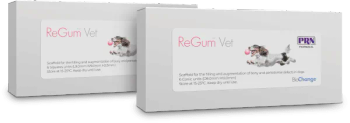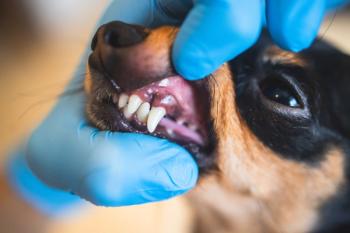
Take time to count your patients' teeth
Missing or extra teeth must be caught early to prevent more serious dental problems down the line.
As companion-animal practitioners, we spend much of our day focused on numbers. We know what the normal white and red blood cell counts should be and what to do when protein and the serum glucose concentrations are too high or too low. What about the teeth? Why is counting them so important?
Before we dive into the specifics of teeth counting, let's review some terminology.
American Veterinary Dental College terminology related to unerupted and partially erupted teeth
Dentigerous cyst: An odontogenic cyst initially formed around the crown of a partially erupted or unerupted tooth; also called a follicular cyst or tooth-containing cyst.
Embedded tooth: An unerupted tooth within its alveolus and covered by bone and soft tissue only.
Impacted tooth: An unerupted tooth whose eruption is prevented by one or more teeth in close proximity.
Pericoronitis: An infection of the soft tissues surrounding the crown of a partially erupted tooth.
Unerupted tooth: A tooth that has not erupted or only partially erupted; it can be embedded or impacted.
When there are too many teeth for the space provided, crowding occurs, predisposing the affected area to periodontal diseases from excessive plaque and tartar accumulation. Missing teeth are not problems when not present subgingivally. In cases in which the supposedly missing teeth are actually embedded or impacted, painful dentigerous cysts can occur. Intraoral radiographs help to determine if a tooth is present subgingivally and, if so, its orientation as well as any radiographic pathology (Photos 1A and 1B).
Photo 1A. Flocculent swelling secondary to an impacted mandibular first premolar causing a dentigerous cyst. (All photos courtesy Dr. Jan Bellows.)
Photo 1B. An intraoral radiograph of the patient in Photo 1A confirming an impacted first premolar and a cyst.
Rostral maxilla and mandibles
In mature dogs and cats, between the maxillary and mandibular canines there should be six evenly spaced incisors per arch (Photo 2).
Photo 2. A normal set of six maxillary incisors.
When there are more (supernumerary incisors), crowding results, decreasing the natural cleaning mechanism and predisposing the area to periodontal disease. Extraction of the supernumerary teeth is indicated when crowding is present (Photos 3, 4A-4C and 5).
Photo 3. Ten teeth, including four supernumerary (SN) teeth, between the canines. The supernumerary teeth were extracted.
Photo 4A. Seven incisors between the maxillary canines. An intraoral radiograph (Photo 4B) helped diagnose the cause and dictate treatment.
Photo 4B. An intraoral radiograph of the patient in Photo 4A shows a deciduous left third incisor as well as a partially erupted adult third incisor.
Photo 4C. An intraoral radiograph of the patient in Photos 4A and 4B after extraction of the two deciduous canines, the deciduous left maxillary third incisor as well as the secondary partially erupted third incisor.
Photo 5. Feline mandibles with a missing right canine and second and third incisors.
Likewise, too few teeth between the canines should be noted and evaluated as well. Fewer than six may be due to congenitally missing teeth, impacted teeth or fractured crowns with retained root fragments (Photos 6A and 6B).
Photo 6A. Only five mandibular incisors are clinically apparent between the canines in this patient.
Photo 6B. An intraoral radiograph of the patient in Photo 6A reveals an unerupted left second incisor.
Maxillary and mandibular cheek teeth
In mature dogs, between the maxillary canine and fourth premolar there should be three teeth-the first, second and third premolars. Between the mandibular canine and first molar there should be four teeth-the first, second, third and fourth premolars (Photo 7).
Photo 7. A normal cheek teeth count in a dog.
In mature cats, between the maxillary canine and the fourth premolar there should be two teeth-the second and third premolars (Photo 8A).
Photo 8A. A normal maxillary cheek teeth count in a cat.
Between the mandibular canine and molar there should be two teeth-the third and fourth premolars (Photo 8B).
Photo 8B. A normal mandibular cheek teeth count in a cat.
Supernumerary premolars causing crowding should be extracted (Photos 9 and 10). This is especially important in small-breed dogs because their teeth are closer together compared with large-breed dogs.
Photo 9. Left maxillary supernumerary premolars. The teeth labeled 4 and 5 were extracted.
Photo 10. A supernumerary maxillary third premolar in a cat before extraction.
Clinically missing teeth need to be investigated with intraoral radiographs to see if the teeth are in fact missing, embedded or unerupted. If the radiographs show an open apex (the dog or cat is less than 8 months old), there is still eruption force available for the tooth to erupt normally. An operculectomy can be performed where a section of the thickened gingiva is surgically removed to allow eruption (Photos 11A-11C).
Photo 11A. A missing mandibular first premolar.
Photo 11B. An intraoral radiograph of the patient in Photo 11A shows the missing premolar in normal orientation.
Photo 11C. An operculectomy was performed in the patient in Photos 11A and 11B to allow the premolar to erupt.
If the patient is older or if the tooth is angled abnormally, the tooth should be extracted to prevent dentigerous cyst formation (Photos 11D and 11E).
Photo 11D. An intraoral radiograph shows a horizontally oriented mandibular first premolar and underlying cyst.
Photo 11E. An intraoral radiograph reveals a dentigerous cyst affecting the first and second mandibular premolars.
Molars
In mature dogs, there should be two teeth-the first and second molars-behind the maxillary fourth premolar (Photo 12) and two teeth-the second and third molars-behind the mandibular first molar (Photo 13).
Photo 12. Two normal molars caudal to the maxillary fourth premolar.
Photo 13. Two normal molars caudal to the mandibular first molar.
In normal cats there is only one maxillary and one mandibular molar. If extra or missing molars are discovered, an intraoral radiographic examination is necessary to identify the cause, which should be treated as appropriate (Photos 14A-14C).
Photo 14A. A missing mandibular third molar.
<
Photo 14B. An intraoral radiograph of the patient in Photo 14A reveals an impacted molar.
Photo 14C. The third molar was extracted in the patient in Photos 14A and 14B.
Newsletter
From exam room tips to practice management insights, get trusted veterinary news delivered straight to your inbox—subscribe to dvm360.






